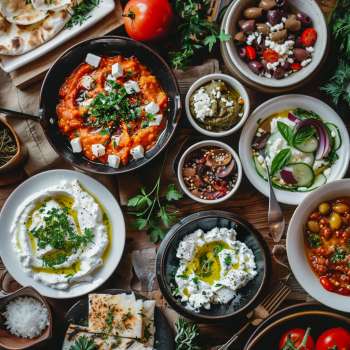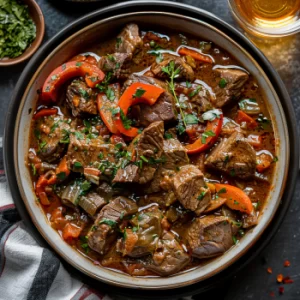Have you ever heard of the captivating Sarikopites, the iconic turban-shaped cheese pies that hail from the idyllic island of Crete? These delectable pastries are a true culinary treasure, seamlessly blending the rich traditions of Cretan cuisine with the distinct flavors of the Mediterranean.


What is it about these Sarikopites that has captivated the hearts and palates of locals and visitors alike? Join us as we delve into the fascinating origins, cultural significance, and mouthwatering preparation of these beloved Cretan recipes.
Key Takeaways
- Sarikopites are traditional turban-shaped cheese pies from the island of Crete, Greece.
- These pastries are made with a simple homemade dough and filled with a creamy cheese mixture, often incorporating local Cretan cheeses.
- The name “Sarikopita” is derived from the “Sariki,” the traditional headgear worn by Cretan men, reflecting the unique shape of these pies.
- Sarikopites are enjoyed as a savory snack or dessert, often drizzled with honey and sprinkled with sesame seeds.
- These cheese pies are a testament to the rich culinary heritage and cultural traditions of Crete, a beloved destination known for its Mediterranean diet and regional specialties.
Delectable Sarikopites: Crete’s Iconic Turban-Shaped Cheese Pies
In the captivating culinary landscape of Crete, one pastry stands out as an iconic regional specialty: the sarikopites. These turban-shaped cheese pies are a beloved delicacy that embody the rich cultural heritage and gastronomic traditions of the island.
Sarikopites are crafted with a homemade dough of flour, water, oil, vinegar, and salt, creating a flaky and crisp texture that encases a creamy filling. The traditional filling features the local xinomyzithra cheese, a tangy and slightly tart variety unique to Crete. For those who cannot access this specialty cheese, a combination of ricotta and feta can serve as a delectable alternative.
The art of preparing sarikopites is a testament to the island’s culinary ingenuity. The dough is carefully rolled out and shaped into individual turban-like forms, each one a labor of love. These pastries are then fried until they reach a golden-brown hue, resulting in a crisp exterior that gives way to a melted, cheese-filled interior.
The final touch is the addition of a drizzle of honey or a dusting of powdered sugar and cinnamon, elevating the sarikopites to a true sensory delight. These cheese pies are not merely a culinary experience but a celebration of Crete’s rich Mediterranean diet and regional specialties.
| Ingredient | Quantity |
|---|---|
| Flour | 2 cups |
| Water | 1 cup |
| Olive Oil | 2 tablespoons |
| Vinegar | 1 tablespoon |
| Salt | 1 teaspoon |
| Xinomyzithra Cheese | 1 cup, crumbled |
Sarikopites are a testament to Crete’s culinary prowess, showcasing the island’s deep-rooted traditions and the enduring appeal of Greek cuisine. These turban-shaped cheese pies are a must-try for anyone seeking to explore the vibrant Cretan recipes and discover the true essence of this captivating Mediterranean destination.
Unraveling the Origins and Significance of Sarikopites
Sarikopites, the iconic turban-shaped cheese pies from Crete, hold a profound significance in the island’s rich culinary heritage. These delectable traditional dishes are deeply rooted in the vibrant Cretan culture and cuisine, reflecting the region’s long-standing traditions and the remarkable influence of the Mediterranean diet.
The Influence of Cretan Culture and Cuisine
The unique shape of sarikopites is believed to be a nod to the Sariki, the traditional headwear worn by Cretan men, which has long been a symbol of Cretan identity and pride. This turban-like form not only lends the pies their distinctive appearance but also serves as a tangible link to the island’s cultural traditions.
The use of local ingredients, such as the renowned xinomyzithra cheese, as well as the traditional methods of preparation, further highlight the deep connection between sarikopites and the Cretan way of life. These regional specialties exemplify the island’s commitment to preserving its culinary heritage, showcasing the diversity and richness of Greek cuisine.
Symbolic Ties to Traditional Headgear
- The turban-like shape of sarikopites is believed to be a nod to the Sariki, the traditional headwear worn by Cretan men.
- The Sariki has long been a symbol of Cretan identity and pride, and the form of the sarikopites serves as a tangible link to this cultural tradition.
- The use of local ingredients, such as xinomyzithra cheese, and the traditional methods of preparation further cement the connection between sarikopites and the Cretan way of life.
Sarikopites, with their distinctive appearance and deep roots in Cretan culture, have become an integral part of the island’s culinary landscape. These cheese pies not only delight the palate but also serve as a testament to the rich heritage and enduring traditions of this vibrant Mediterranean region.
Sarikopites, Cheese Pies, Cretan Recipes: A Trio of Culinary Delights
Sarikopites, the turban-shaped cheese pies, are just one shining example of Crete’s rich and diverse culinary heritage. These delectable pastries, filled with a harmonious blend of creamy ricotta and tangy feta cheese, are a testament to the island’s commitment to preserving its traditional dishes. Alongside the iconic sarikopites, Crete is home to a vast array of cheese pies and Cretan recipes that have endured the test of time, each with its own unique story to tell.
From the use of locally sourced Feta cheese and fragrant Myzithra cheese to the intricate art of working with phyllo dough, Cretan cuisine is a tapestry of flavors and techniques that reflect the region’s deep-rooted connection to the Mediterranean diet and its regional specialties. These traditional dishes not only nourish the body but also the soul, preserving the cultural traditions that have shaped the island’s identity for generations.
Whether you’re savoring the flaky, golden-brown crust of a sarikopite or indulging in the creamy, tangy filling, these culinary delights offer a window into the vibrant and diverse Greek cuisine that calls Crete home. From family gatherings to festive celebrations, these Cretan recipes continue to captivate and delight, reminding us of the power of food to connect us to our heritage and the land that nourishes us.
| Cretan Cheese Pie Varieties | Key Ingredients | Preparation Method |
|---|---|---|
| Sarikopites | Ricotta, Feta, Myzithra | Phyllo dough, Baking or Frying |
| Kalitsounia | Ricotta, Myzithra | Phyllo dough, Baking |
| Sfakiani Pites | Feta, Myzithra | Bread dough, Baking |
These Cretan cheese pies, each with their own unique character and flavor profile, showcase the region’s commitment to preserving its culinary heritage. From the turban-shaped sarikopites to the rustic sfakiani pites, these traditional dishes continue to captivate and delight, reminding us of the power of food to connect us to the land and the people who have nurtured it for generations.
The Art of Making Authentic Sarikopites
Creating the perfect Sarikopites, the iconic Cretan cheese pies, is a true culinary art form that has been passed down through generations of Cretan cooks. From crafting the delicate phyllo dough to mastering the flavorful cheese filling, every step in the preparation of these traditional dishes requires a keen understanding of Cretan culinary traditions.
Crafting the Perfect Dough
The foundation of any great Sarikopite lies in the dough. Cretan cooks have perfected the art of kneading and rolling out the phyllo dough to create a thin, flaky crust that perfectly complements the rich cheese filling. The key is to strike the right balance between elasticity and tenderness, ensuring the dough is easy to work with while retaining a delicate texture.
Mastering the Cheese Filling
The heart of the Sarikopite is the cheese filling, a blend of Myzithra cheese, Feta cheese, and sometimes even ricotta. Crafting the perfect filling requires a delicate touch and a deep understanding of Cretan cheese-making traditions. The goal is to achieve a filling that is creamy, tangy, and perfectly balanced, with the flavors of the local cheeses shining through.
From kneading the dough to carefully assembling and shaping the pies, every step in the preparation of Sarikopites is an exercise in culinary artistry, reflecting the dedication and passion of Cretan cooks. These regional specialties are not just a treat for the taste buds, but a celebration of the rich Cretan cuisine and its enduring place in the Mediterranean diet.
Frying vs. Baking: Two Delicious Preparation Methods
The beloved Sarikopites, Crete’s iconic cheese pies, can be prepared using two distinct methods: frying and baking. While the frying technique results in a golden, crisp exterior and a light, flaky texture, the baking approach offers a healthier alternative that still captures the essence of this Cretan delicacy.
The fried version of Sarikopites showcases the versatility of this beloved pastry, as the high heat seals in the flavors of the feta cheese and myzithra cheese fillings, creating a mouthwatering experience. On the other hand, the baked Sarikopites provide a more balanced and wholesome option, allowing home cooks to enjoy the traditional dishes of Greek cuisine without compromising their dietary needs.
Regardless of the preparation method, both fried and baked Sarikopites capture the essence of Cretan culture and the Mediterranean diet, making them a true regional specialty that can be savored and shared with loved ones. Whether you prefer the indulgent crispiness of the fried version or the healthier appeal of the baked option, Sarikopites are a culinary delight that will transport you to the heart of Crete with every bite.
FAQ
What are Sarikopites?
What is the traditional filling for Sarikopites?
Where does the name “Sarikopites” come from?
How are Sarikopites typically served?
What is the significance of Sarikopites in Cretan culture and cuisine?
How are authentic Sarikopites made?
What are the different ways to prepare Sarikopites?
Welcome to “Cooking with Greek People,” your go-to YouTube channel for discovering the rich, flavorful, and diverse world of Greek cuisine! Whether you’re a seasoned chef, a home cook, or someone who just loves great food, our channel is designed to bring the heart of Greece into your kitchen.


Healthy Greek Cooking for Modern Lifestyles
Greek cuisine is evolving with modern twists on traditional dishes, blending Mediterranean flavors with global influences. From quinoa moussaka to lentil dolmades, these recipes cater to health-conscious diners while preserving authentic tastes. Greek fusion recipes combine the bold flavors of Greece with the aromatic profiles of Asian ingredients, offering unique culinary experiences like miso-glazed lamb souvlaki and tzatziki-stuffed chicken skewers.
Vegan Greek recipes are transforming traditional dishes into plant-based versions, highlighting the versatility of Greek ingredients. For more details and recipes, visit the following links: Modern Greek Recipes, Modern Greek Salads, Easy Greek Dinners, Greek Breakfast Recipes, Greek-Inspired Cocktails, Greek BBQ Recipes, Greek Snack Recipes, Greek-Inspired Soups, Greek Pasta Dishes, and Greek-Inspired Pizza.
Author: Bob
With over 20 years in Bioinformatics and AI in Molecular Diagnostics, Bob Stavrou advises BiCos, focusing on authenticating OLIVE OIL DNA. He's also a passionate contributor to YouTube Cooking with Greek People and appeared on Greek TV show Savvatokiriako Me Ton Manesi, bridging science and culinary arts. Watch it on Alpha TV.





